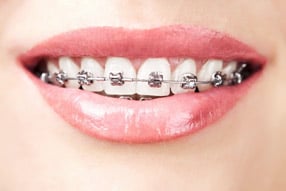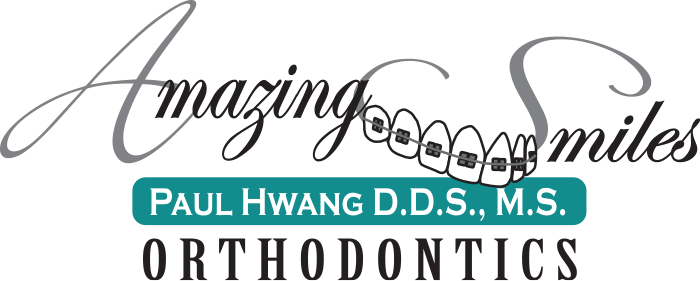Orthodontic Treatments in Sylvania, Swanton, Toledo and Northwestern Ohio

Straight, evenly arrayed teeth are an important part of every unforgettable smile. They are also central to ensuring optimal oral health and boosting self-confidence in social situations. Trusted Northwest Ohio dentist Dr. Paul Hwang is skilled in a wide range of orthodontic technologies, from traditional metal braces to ceramic, lingual and clear aligner options.
Am I a Candidate for Braces?
Braces can correct mild to severe teeth misalignment and bite irregularities including:
- Crooked, crowded or protruding teeth
- Gaps and spaces in between teeth
- Malocclusion (“bad bite” due to a misaligned jaw)
- Teeth that have shifted due to injury
Braces can help improve several functional problems that result from crooked teeth and bite problems such as:
- Difficulty chewing or biting
- Difficulty speaking
- Facial pain due to grinding or clenching teeth (bruxism)
Dr. Hwang offers several types of braces for adolescents and adults:
Traditional Metal Braces
Traditional braces are made of stainless steel metal in a network of brackets, archwires and elastic bands. They work by putting gentle, constant pressure on the teeth in order to gradually shift them into an aligned position. Today, traditional braces are lighter in weight and structure than ever before. Brackets are connected to an archwire with tiny elastics known as ligatures or o-rings, which will be changed during each appointment to increase the pressure on your teeth.
Ceramic Braces
These braces function the same way as metal braces do, but differ in their appearance. Made of clear, ceramic material, ceramic braces are preferred by many patients because they are less noticeable. Occasionally the elastics may become discolored, which can also temporarily discolor the teeth. Use of an appropriate toothpaste can mitigate this issue.
Lingual Braces
Lingual braces use the same brackets and wires used in metal braces but are installed behind the teeth. Like metal braces, lingual braces work by putting constant pressure on the teeth to move them into proper alignment.
Damon Braces
Damon braces offer a gentler approach to moving teeth. These braces are self-ligating, which means the brackets do not need o-rings. Instead, Damon braces use a slide mechanism to connect the archwires.
This option requires fewer dental visits because the braces do not need to be continually adjusted. This generally translates into lower cost. Because the teeth experience a more constant pressure, rather than heavier pressure after an adjustment, there is also less discomfort. In addition, patients find that Damon braces are easier to clean.
Invisalign®
Invisalign aligners are preferred by many patients thanks to their clear design. Patients receive a series of custom-made aligners over the course of treatment. Each one gradually nudges crooked teeth into place, often in less than a year. The aligners are removable, which makes cleaning much easier than traditional wire braces. Because the aligners are made of a clear, resilient plastic material, they are barely noticeable to those around you.
Forsus Appliances
Forsus appliances are a relatively new treatment for noticeable overbites. This advanced option has replaced the bulky headgear that adolescents once dreaded. Instead of the old exterior appliance, the Forsus technology uses a spring, attached to braces, that is worn inside the cheeks. Over time it gradually moves the upper or lower jaw into a more natural position, enhancing the overall facial profile.
Palatal Expanders
When it comes to overcrowding in the mouth, the laws of physics are pretty clear: The mouth either needs fewer teeth or more room for the existing teeth. Traditionally, orthodontists recommended extracting a sufficient number of teeth to relieve the overcrowding and set the stage for successful orthodontic treatment. Palatal expanders provide a new option. The palatal expander is a device that uses pressure to move molars further back in the mouth, opening up space for other teeth to move into straight, evenly arrayed positions.
Treatment Timeline
During your orthodontic consultation, Dr. Hwang will thoroughly examine your teeth and mouth, as well as evaluate your oral health. Photographs and X-rays will be taken to help Dr. Hwang plan your treatment. For the first few days after getting your braces, your mouth may feel sore and tender. Temporary, minor discomfort is also normal after your regular orthodontic appointments when your braces are adjusted. Traditional braces are worn 24/7 and are typically in place for one to two years; it depends on the patient’s dental and orthodontic needs.
Cost of Braces

The cost of braces depends on several factors, including the type of braces used and the complexity of treatment. Your braces may be partially covered by your dental insurance if your plan includes orthodontic treatment.
Schedule Your Consultation Today
To learn more about orthodontic options, please schedule a consultation with Dr. Hwang in our Sylvania or Swanton office. To accommodate your busy schedule, we offer appointments in the evening and on Saturdays.


